Editors note: This is a continuation of an earlier post. On Friday, July 10th I spent the night with the FS Detroit production crew. All the pregame preparations are done at this point, and it is just minutes before 7:00.
It is about 3 minutes before the the 7 p.m. start of the broadcast and producer Mark Iacofano is soaking up a little bit of fresh air. His chair in the truck is occupied by Chris Wasielewski who is wrapping up the Tigers Live pregame show.
As soon as the clock hits 7:00 the opening title sequence that was prepared 2 hours earlier hits the monitors. When I last saw it there was a nice video montage with the signature Fox Sports music. This time play-by-play announcer Mario Impemba provided the narration that was absent before. And with that we were underway.
My setup was pretty sweet. My home for the next couple hours was right in the middle of the truck. The main production suite was to the left of me and tape-land was to the right. I was also right by the A/C so I was nice and comfortable. I had the desk space that is occupied by the visiting producer when the truck is being shared. Cleveland games are broadcast on Sports Time Ohio and they have their own facilities. I had room to plug-in my laptop, a headset so I could listen to Iacofano and director Brian Maas, and a hook-up to the wireless router in the truck.
The first thing that I observed from having the headset on is that I had no idea what was going on. There was a lot of dialogue and it was all coming very quickly. Every time a camera is switched, that is called by the director. Every time a graphic goes up, that’s another instruction, and those graphics come down as well which means another instruction. Next time you tune into a game take out a blank piece of paper and grab a pencil. Every time something changes on the screen (graphics, replays, camera changes) make a hash mark. At the end of the half inning count up those marks and you’ll get a flavor for how many commands are coming just from the director.
In addition to trying to provide all the visuals, the truck is also responsible for timing the start correctly. It would be nice if the pitcher emerged from the dugout at 7:04, but that’s not always the case. On this particular night Edwin Jackson was running a couple minutes late. The broadcast was back from break, but Jackson wasn’t on the mound yet meaning they couldn’t pop up Jackson’s season numbers on the screen and Allen couldn’t read through them. So Iacofano decides to do the Arby’s spot. He tells Impemba and the Arby’s 3 homer graphic comes up on the screen. While Impemba describes the promotion Maas sees the players taking the field so they cut to that shot and get rid of the Arby’s splash. To the viewer it is seamless. In the truck 35 things just happened on the fly in the last 2 minutes.
Before it even seemed like the game had started, the top half of the first was done as Jackson pitched a 1-2-3 inning. With 2 outs Iacofano is at the ready, and with 2 strikes he’s really ready knowing that the next pitch could end the inning. Ready for what you ask? They need to throw up the score, next batters up, fade to commercial, cut the microphones, and count it down to master control.
Master control is located in Houston and serves kind of as mission control for all Fox Sports broadcasts on a given night. They run the commercials so every break is counted in and out with master control. Occasionally during an inning (a couple times per game usually), master control will ask permission for “a squeeze.” What they are asking for is permission to run the the Fox Sports ticker across the bottom.
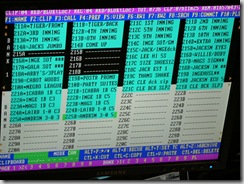 The bottom of the first inning was uneventful but it gave me a little more time to be less overwhelmed. As I find my groove listening to the headset traffic and trying to take in 8 monitors there is a near collision between Josh Anderson and Magglio Ordonez in right center. This prompts a series of replays as the guys in tape-land just continue to churn through every camera shot looking for things that might have been missed. Plays like the Ordonez/Anderson one get logged in for later use. It’s only the second inning so it’s hard to say what might be important or develop into a story line during the game. Anderson getting a rare start in centerfield and struggling might be something to keep an eye on.
The bottom of the first inning was uneventful but it gave me a little more time to be less overwhelmed. As I find my groove listening to the headset traffic and trying to take in 8 monitors there is a near collision between Josh Anderson and Magglio Ordonez in right center. This prompts a series of replays as the guys in tape-land just continue to churn through every camera shot looking for things that might have been missed. Plays like the Ordonez/Anderson one get logged in for later use. It’s only the second inning so it’s hard to say what might be important or develop into a story line during the game. Anderson getting a rare start in centerfield and struggling might be something to keep an eye on.
The other thing that this play spurs is a bunch of commentary from the truck about what had just transpired. These guys (and gals) had been all business, but with that play they started to talk like fans, analyzing who’s ball it was and what went almost wrong. This caught me by surprise, and I’m not sure why. I had wrongly assumed that while I was sure these people liked their jobs and baseball, I didn’t expect them to be such fans. The truck would make the same comments many of us would make while sitting and watching the game with friends.
The Tigers break through for some runs in the bottom of the 2nd inning. After back to back singles from Inge and Ordonez Gerald Laird lifts a ball down the right field line. When the ball leaves the bat Maas sees the reaction of the fielders and calls out the appropriate camera. Ryan Garko feebly dives for the ball, and before he even has stopped skidding on his stomach Maas has shouted out “we got that on X-mo” (x-mo is the super slow motion camera usually positioned in the visitors dugout, today it is above third base in the concourse). Another flurry of replays comes and it is capped off with the perfectly captured X-Mo shot.
I spoke already of the director setting up the broadcast with appropriate video. While all those commands are flowing out, the director and producer are also listening to the announcers. They are listening both to the audio going over the air as well as talk-back that only goes into their headsets. They have to match the pictures to the stories or analysis provided by Rod Allen and Impemba.
But this isn’t a one way street either. There is a lot to see at a baseball game, and no one person can see it all. Rod and Mario can see the whole field, but can’t see everything happening. Sometimes the truck has a better view with a dozen cameras at their disposal and sometimes catch something that the announcers don’t, like a player in the dugout being tended to by trainer Kevin Rand (like he was taking care of Miguel Cabrera on this night).
There is a tremendous amount of collaboration that takes place with everyone looking to provide the most information to the viewer. During my earlier tour with Iacofano we discussed this collaboration. We talked about a game 2 years ago when the Fox Sports did an isolation on Travis Hafner being too deep in the box. It was something that Allen had noticed and a point that Pudge Rodriguez argued a few pitches later. In that same game Rod and Mario commented on how long Rafael Betancourt was taking between pitches. Next thing you know the truck had a shot of umpire Doug Eddings with a stop watch while Impemba was quoting the rule. These things seem trivial at home, but in the context of everything going on they are remarkable.
Iacofano talked about how Kirk Gibson time after time would pick up on a pitcher tipping pitches – and he’d do it from the booth. They’d go in tight from centerfield and he’d be right time and time again. Announcers can say “dumb things” from time to time, but really, it isn’t as simple as just talking about sports. You have a producer or director in your ear. You’re watching everything, and you’re talking for 3 hours straight. This isn’t a simple task.
And speaking of the producer, he is telling a story himself, and a story with constraints. So much of what comes is completely subtle you’d never notice it. When the Indians got their first hit in the 4th inning the Fox Box switches to the Runs-Hits-Errors scoreboard. When Josh Anderson was rubbing the baseball sized (and marked) welt on his tricep out on second base, it was the perfect time to run a promotion for the Detroit Medical Center.
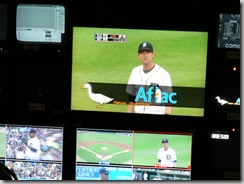 Speaking of sponsored elements, there are a lot in a game. They all get fit in somehow. Some have set spots, like the Aflac Trivia question (prompted by “cue the duck’”). Others are more dynamic. One of the more popular ones is the Belle Tire Pitch-by-Pitch. It is a matter of looking for the perfect moment to break it out, and sometimes that perfect moment takes a few tries:
Speaking of sponsored elements, there are a lot in a game. They all get fit in somehow. Some have set spots, like the Aflac Trivia question (prompted by “cue the duck’”). Others are more dynamic. One of the more popular ones is the Belle Tire Pitch-by-Pitch. It is a matter of looking for the perfect moment to break it out, and sometimes that perfect moment takes a few tries:
- 5th inning, Miguel Cabrera: Cabrera was up with runners on 1st and 2nd and everything was cued up for a pitch-by-pitch. A 2 pitch ground out wasn’t what they were looking for though.
- The same drill and same inning only with Marcus Thames this time. A strikeout wasn’t the feel good story that the crew wanted.
- Shin Soo Choo had walked his first time up. A 3 pitch ground out didn’t really fit the script though.
- Grady Sizemore came up in the 8th and time was running out but he only saw 2 pitches.
- Choo was up also in the 8th. This time with 2 runners on and Bobby Seay comes into face him. Seay fans him on 4 pitches and that is the moment worthy of a pitch-by-pitch
If it sounds like I’m a little in awe, it’s because I am. This was a relatively clean and crisp game and broadcast. This crew does almost 150 a year. The baseball season really is a grind, and it goes on for 6 months. And maybe it was the off-day the day before, or the thought of the All Star break coming up, but things stayed light the whole time. After a George Kell package ran, Iacofano produced the rest of the half inning with a rather poor imitation of Kell’s Swifton, Arkansas bred drawl.
After a tenuous non-save situation outing from Fernando Rodney the broadcast was done. Wasieliewski jumps back in the producer chair as the postgame show hits the air. In another 60 to 90 minutes everybody will be on their way home, after spending 10 hours at the stadium.
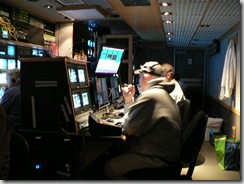
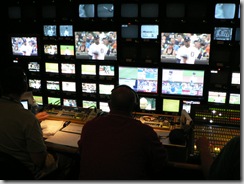
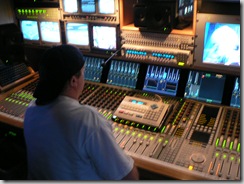 The final area of the truck is the audio booth. It is actually a separate area of the truck with its own entrance. It is a dizzying array of dials and sliders that allow the audio director (Andy Bartley) to cue the music, open and close and level Rod & Mario’s microphones, and manage microphones around the stadium that pick up crowd noise and the crack of the bat.
The final area of the truck is the audio booth. It is actually a separate area of the truck with its own entrance. It is a dizzying array of dials and sliders that allow the audio director (Andy Bartley) to cue the music, open and close and level Rod & Mario’s microphones, and manage microphones around the stadium that pick up crowd noise and the crack of the bat.